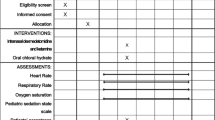Abstract
Objective
To evaluate the safety and efficacy of intranasal midazolam for seizures and various procedures.
Methods
Prospective randomized study. Total 125 children of all ages of either sex, for seizure episode (n-76) and various invasive and non-invasive procedures (n-49) received either intranasal midazolam (0.2 mg/Kg) or intravenous diazepam (0.3 mg/Kg).
Results
Mean time from arrival at hospital to starting treatment was significantly shorter in midazolam group compared to diazepam group [2.34±0.90; minute vs 4.61±1.08 minute p<0.001]. Mean time to control seizures after arrival in hospital was significantly shorter in midazolam group compared to diazepam group [5.25±0.86 minute vs 6.51±1.06 minute p<0.001].
Conclusion
Midazolam by the intranasal route provides safe and equally effective non-invasive method of sedation for procedures and seizures.
Similar content being viewed by others
References
Krauss Baruch, Steven M Green. Sedation and analgesia for procedures in children.New England J Med 2000; 342 (13): 938–945.
Gopinath PG, Gopinath G, Kumar TCA. Target site of intranasally sprayed substances and their transport across the nasal mucosa: a new insight into the intranasal route of drugdelivery.Curr Ther Res 1978; 23: 596–607.
Kida S, Pantazis A, Weller RO. CSF Drains Directly from the Subarachnoid Space into Nasal Lymphatics in the Rat-Anatomy, Histology and Immunological Significance.J Neuropathology and Applied Neurobiology 1993; 19: 480–488.
Latson Larry A, Chaetham JP, Gumbiner CH, Kingler JD, Danford DA, Hofschire PJ. Midazolam Nose Drops for Outpatients Echocardiographic Sedation in Infants.Am Heart J 1991; 121: 209.
Wilton NCT, Leigh J, Rosen DR, Pandit U. Preanesthetic sedation of preschool children using intranasal midazolam.Anesthesiology 1988; 69: 972–975.
Lahet ELi, Micheal G, Joseph B, Tzvi B, Matithyahu B. Comparison of intranasal Midazolam with intravenous Diazepam for treating febrile seizures in children-prospective randomized study.British Med J 2000; 321: 83–86.
Slover R, Schlesinger T. Use of intranasal midazolam in preschool children.Anaseth Analg 1990; 70: 51–54.
Fishbein Mark, Lugo Ralph A woodland Jennifer, Lininger Barbara and Linscheid Tom. Evaluation of intranasal midazolam in children undergoing esophagogastroduodenoscopy.J Pediatr Gastroenterol Nutr 1997; 23(3): 261–266.
Author information
Authors and Affiliations
Corresponding author
Rights and permissions
About this article
Cite this article
Mittal, P., Manohar, R. & Rawat, A.K. Comparative study of intranasal midazolam and intravenous diazepam sedation for procedures and seizures. Indian J Pediatr 73, 975–978 (2006). https://doi.org/10.1007/BF02758299
Issue Date:
DOI: https://doi.org/10.1007/BF02758299




